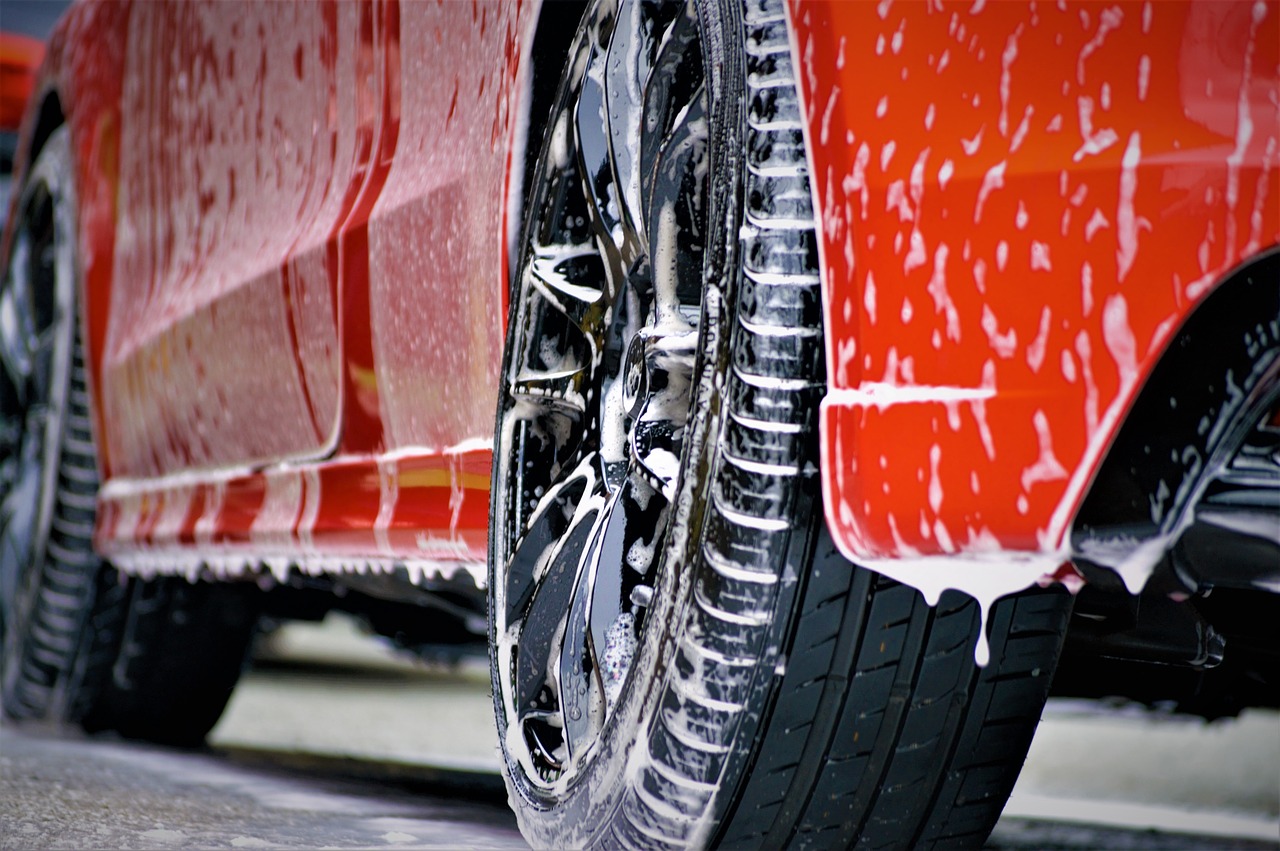
In car detailing, shampooing refers to cleaning a car’s interior or exterior using a special shampoo or cleaning solution. For the exterior, car shampoo is mixed with water and applied to the vehicle’s surface using a sponge, mitt, or foam cannon. This helps remove dirt, grime, and other contaminants from the paint without scratching it. The shampoo is designed to be gentle but effective, leaving the car clean and ready for waxing or polishing. For the interior, shampooing is used to clean the seats, carpets, and upholstery. A fabric cleaner or shampoo is applied to these surfaces, then scrubbed in with a brush or cleaned with a machine that removes dirt and stains. Once the cleaning solution is worked in, the area is vacuumed, rinsed, and dried. Shampooing the interior not only helps remove dirt and stains but also freshens up the car’s interior and gets rid of bad odors.
What Is Car Shampooing?
Car shampooing is the process of washing your car using a special shampoo made for vehicles. It’s an important part of car care because it helps remove dirt, grime, and other stuff that can build up on your car’s surface, while also protecting the paint. Unlike regular soap, car shampoo is designed to be gentle on your car’s paint and won’t strip away protective layers like wax or sealant.
Car shampooing keeps your car looking clean and shiny. Dirt, road salts, bird droppings, and tree sap can all stick to the surface, and if left on too long, they can damage the paint or cause stains. Shampooing your car regularly helps remove these things and protects the finish.
Shampooing helps protect the paint. A clean surface makes it easier to apply wax or sealants, which add extra protection against the sun, rain, and pollutants. These things can cause fading, rust, or other damage over time, so keeping your car clean helps prevent that.
Shampooing gives your car a smooth, fresh finish that looks great and makes it easier to spot any scratches or chips in the paint. Regular car shampooing is an important part of taking care of your vehicle, helping it stay looking good and keeping its value for longer.
Some of The Key Stages of Car Detailing
- Wheels: Start with the wheels, as they carry the most dirt and grime.
- Pre-Cleaner (Stage One): Apply a pre-cleaner to loosen surface contaminants before washing.
- Shampooing (Stage Two): Use a snow foam to lift dirt without touching the paint, reducing the risk of scratches.
- Two-Bucket Method Contact Wash: Wash the car using the two-bucket method to keep dirt away from the paint.
- Decontamination Stage: Remove embedded contaminants using clay or specialty cleaners.
- Drying: Carefully dry the car with microfiber towels to avoid water spots.
- Polishing: Polish the paint to enhance gloss and remove minor imperfections.
- Glaze: Apply a glaze to add depth to the paint before sealing or waxing.

Car detailing is a step-by-step process that helps keep your car looking clean and well-maintained. It starts with the wheels, which are usually the dirtiest part of the car. Since wheels collect brake dust, dirt, and grime, it’s important to clean them first using a wheel cleaner. After that, a pre-cleaner is applied to the body of the car. This helps loosen any surface dirt or contaminants, like road salt or bird droppings, making it easier to clean without scratching the paint. Then comes the snow foam stage, where a thick foam is sprayed over the car. This foam lifts dirt off the surface, so when you rinse it off, less dirt will stick to the car, reducing the chance of scratches.
Once the foam is rinsed, it’s time for the two-bucket method contact wash. This method uses two buckets, one with soapy water and one with clean water to rinse off your mitt or sponge. This way, the dirt stays in the rinse bucket and doesn’t get back on the car’s paint. After washing, the decontamination stage comes in. At this point, a clay bar or special cleaner is used to remove any leftover contaminants that washing couldn’t get rid of, like tree sap or stubborn dirt particles.
Next, it’s time to dry the car using microfiber towels. This helps prevent water spots and keeps the paint smooth. After drying, the polishing stage can remove any small imperfections, like swirl marks or light scratches, while also making the paint shine again. Finally, a glaze is applied to give the car’s paint a deeper, glossy look before finishing with a layer of wax or sealant for extra protection. Each of these steps is important for getting your car to look its best and keeping it in great condition.
What to Do After Shampooing Your Car
After shampooing your car, use towels to absorb as much moisture as possible from the seats, using multiple towels if needed. This step helps lift away the remaining water and cleaner from the surface. If possible, leave your car in the sun with the windows or doors open for a few hours to help it dry completely.
How Long Does It Take for a Car to Dry After Shampooing?
The drying time for a car after shampooing depends on the cleaning method and the weather. On a warm day, drying typically takes 2 to 3 hours, while colder days can extend the time to 3 to 6 hours.
How Long Does It Take to Fully Detail a Car?
The time needed for detailing varies based on the type of detail. A quick interior clean takes about two hours, while a full exterior detail can take up to two days. Regular detailing for smaller cars typically takes around four hours, while larger vehicles may require seven or more.
Is My Car Too Dirty for Detailing?
Before beginning the detailing process, it’s important to ensure your car is clean. Depending on its condition, you may need a maintenance wash, full decontamination, or a deep clean using a strong citrus shampoo to remove heavy dirt and contaminants.
How Long Does Car Shampoo Last?
Car shampoo typically lasts around 18 months once opened and up to 36 months unopened. However, these timelines may vary depending on the brand and storage conditions. If you wash your car regularly, like once a week, the shampoo will be used up faster. If you wash it less often, such as once a month, the bottle will last longer. The type of shampoo also matters—concentrated shampoos require less product for each wash, so they tend to last longer. Larger bottles, such as those with 32 oz or 1 liter, will also last longer than smaller ones. To get the most out of your shampoo, it’s important to store it properly. Keeping it in a cool, dry place and making sure the bottle is tightly sealed will help it stay effective. If you wash your car often, a bottle might last about 3 to 6 months, but if you wash less, it could last up to a year or even longer.
Does Car Shampoo Damage Paint?
Car shampoos are designed to quickly remove dirt and grime, often containing harsher chemicals. While effective at cleaning, these ingredients can sometimes strip away paint or wax if used too frequently or improperly.
How Often Should I Wash My Car?
While your car may feel and smell fresh after a thorough detailing, frequent washing isn’t necessary. A simple wash every two weeks, waxing every six months, and occasional interior cleaning will keep your vehicle in great condition.
Can I Use Dawn to Wash My Car?
Dawn and other dish soaps are designed to cut through grease, but they should never be used on your car. These harsh detergents can strip away your car’s clear coat and protective wax. Stick to specialized car wash soaps for safe and effective cleaning.

Are Automatic Car Washes Bad for Your Car?
While some automatic car washes are safe, others can be bad for your car. If you don’t dry your car thoroughly afterward, residual water can cause scratches that may appear later. While automatic car washes can be quick and convenient, they can sometimes cause damage to your car if not used carefully.
One of the main concerns is that some automatic car washes use brushes or rollers to clean your car. These brushes can pick up dirt and debris from previous cars, and if they aren’t cleaned often, they can scratch or damage your car’s paint. The friction from these brushes can leave swirl marks or light scratches, which may build up over time and affect your car’s appearance.
Another problem is that some automatic car washes use strong chemicals that may be too harsh for your car’s paint. These chemicals can strip away wax or protective coatings, which help protect the paint from dirt, water, and the sun. Without that protection, your car’s paint could fade or get damaged more easily.
Touchless automatic car washes, which use high-pressure water and soap instead of brushes, are gentler on the paint. They are less likely to scratch your car, but they might not be as effective at removing tough dirt or grime.
Automatic car washes aren’t necessarily “bad” for your car, but they do have some risks. If you use them a lot, especially if the equipment isn’t well-maintained, they could cause damage over time. To protect your car’s paint, hand-washing is the safest method, or you can choose a touchless automatic wash if you need a quicker option.
When Should You Avoid Washing Your Car?
It’s important to choose the right time to wash your car to avoid causing any damage. You should avoid washing your car when the outside temperature is below freezing (32°F) because water can freeze on your car’s surface, leading to ice buildup that’s hard to remove. This could also cause damage to your car’s paint or trim. If you can, try to wash your car when the temperature is at least 49°F to avoid these problems. The best temperature range for washing your car is between 50°F and 89°F. Washing your car in warmer temperatures helps the water dry faster and prevents any potential freezing or water spots from forming.
Is It Better to Wash Your Car at Home or at a Car Wash?
Washing your car at home may seem convenient, but it can lead to significant water waste. While both home washes and professional car washes use a lot of water, most commercial car washes recycle water, making them a more eco friendly option. Car wash facilities are equipped with special tools and cleaning solutions that can achieve a thorough clean without the risk of harming your car’s paint. If you’re concerned about water usage and want to ensure a high quality wash, a local car detailer is often the better choice for both your car and the environment.
Does a Foam Cannon Really Work?
Yes, foam cannons really work! They spray thick foam onto your car, which sticks to the surface and helps break down dirt and grime. The foam also acts like a cushion, protecting your car’s paint from scratches while lifting off debris. Using a foam cannon or foam gun can make washing your car easier, faster, and more thorough. The foam helps the cleaner work better, giving your car a cleaner and shinier look.
What Is a Good Substitute for Car Shampoo?
For a good substitute for car shampoo, household items like dish soap, baking soda, or baby shampoo can serve as quick car shampoo. While these options aren’t as specialized as commercial car cleaning products, they can be effective in a pinch, offering an accessible solution for shampooing your car. It’s important to note that these alternatives may not provide the same level of protection for your paint or finish, so they’re best suited for occasional use rather than regular washing.
What Is the Safest Car Wash for Your Car?
The safest car wash options for your car are touchless car washes and handwashing. Touchless car washes use high-pressure water and gentle soaps to remove dirt and grime without making contact with your car’s surface, reducing the risk of scratches or paint damage. If you prefer, handwashing can also be an effective way to clean your car while allowing you to control the process and minimize potential damage. Both methods are excellent choices for maintaining your car’s appearance while protecting its finish.
What Happens if I Never Wash My Car?
Neglecting car washes & never washing your car can lead to the buildup of dirt, dust, road grime, and other contaminants on your vehicle’s surface. Over time, these substances can cause damage to your car’s paint and clear coat, leading to dullness, discoloration, and even rust. Regular cleaning helps maintain your car’s appearance and protects it from long-term damage, preserving both its value and aesthetic appeal.
Note: Try a professional shampooing service! Check out our detailing services or try these steps yourself for a spotless shine!

